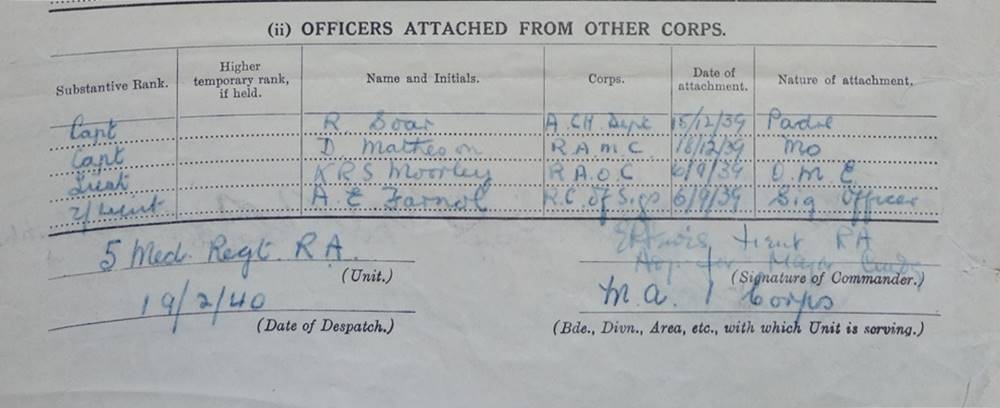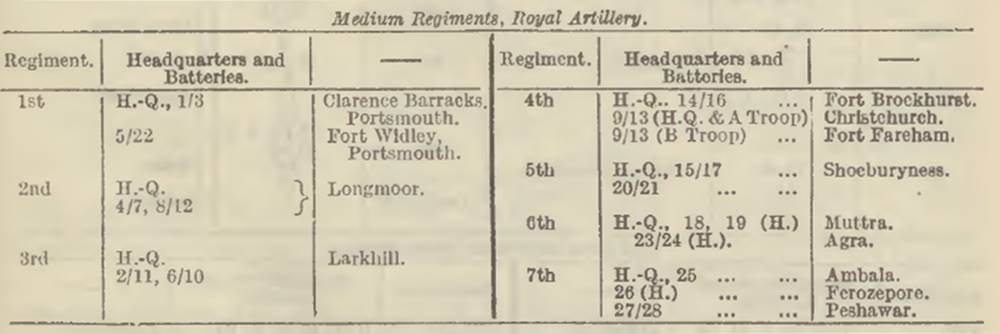This article looks at the role of a medium regiment of the Royal Artillery in the Second World War. It will show you how a medium regiment was structured and how to research both the regiments themselves and the soldiers who served with them. This guide is one of a series I’ve created to help you research soldiers who served in the British Army during the Second World War:
I also offer a Soldier Research and Document Copying Service.
Medium Regiments Royal Artillery in the Second World War
In 1938, the Royal Artillery was reorganized and what had been known as medium brigades became medium regiments. These units provided heavier calibre artillery support to the British Army and on the outbreak of war were equipped with either the 6-inch 26-cwt breech-loading howitzer or 60-pounder breech-loading gun. These were later replaced by breech-loading 5.5-inch guns. Medium regiments often served as part of general headquarters troops or corps troops, but could also come under the command of an infantry division. At the start of the war, a medium regiment was divided into a headquarters and two batteries, with each battery divided into two troops. For example, the 5th Medium Regiment contained a Headquarters and the 15/17th and 20/21st Medium Batteries. The former battery lettered its troops A and B and the latter battery C and D. Each troop contained a headquarters and two sections, with each section containing two guns. This gave a medium regiment a strength of sixteen guns at the start of the war, though this figure was later increased.
The following war establishment was published in May 1939 for a medium regiment consisting of two 6-inch howitzer batteries. This establishment was used for the first two years of the war. A medium regiment was commanded by a Lieutenant-Colonel with a Major as second-in-command. A Major also commanded each battery with each troop commanded by a Captain. There were twenty-four officers with a medium regiment and 622 other ranks, giving a total of 646 all ranks. In addition, there was a medical officer from the Royal Army Medical Corps, a Chaplain, along with his Batman-Driver and four Fitters from the Royal Army Ordnance Corps, later the Royal Electrical and Mechanical Engineers. Most of the other ranks worked with the guns, were Drivers, or Signallers.
For vehicles, the regiment had dozens of trucks and lorries, a couple of cars, forty motorcycles and eighteen tractors to pull the guns. For the soldiers’ weapons, a medium regiment had a mixture of Lee-Enfield rifles, Webley revolvers, light machine guns (Lewis or Bren guns), and the Boyes Anti-tank Rifle. A medium regiment also had a signal section attached to it from the Royal Corps of Signals to help with its communication and a light aid detachment (L.A.D.) from the Royal Army Ordnance Corps/ Royal Electrical and Mechanical Engineers to help with the recovery and repair of guns and vehicles. A platoon from the Royal Army Service Corps could also be attached to a medium regiment.
How to Research a Medium Regiment
The most important document to research a medium regiment during the war is its war diary. This was written by an officer of the unit and recorded its location and activities and they usually contain appendices in the form of orders, maps, and battle reports. War diaries are held at the National Archives and there will usually be between four and eight for each medium regiment. I’ve written a separate article on war diaries and offer a document copying service for them. There may also be separate war diaries for the regiment’s batteries. If you know which formation a medium regiment served with, there will often be other war diaries to check. These war diaries are usually very large as they cover all artillery units serving with that formation.
For example, the 5th Medium Regiment spent most of its time in the British Expeditionary Force serving as corps troops to I Corps (1st Corps). As well as a war diary covering the Regiment, there is another war diary for the I Corps Commander Corps Medium Artillery which will contain further information. If you’re researching a medium regiment that served with a corps in-depth, you’ll want to look through the commander corps medium artillery’s (C.C.M.A.) war diary. It can be difficult to find out which formation a medium regiment served with, as orders of battle are held at the National Archives in London. Usually, the information is recorded in a unit’s war diary. The extract below was taken from a field return of officers for the 5th Medium Regiment which shows in the bottom right-hand corner that the Regiment was serving as part of the medium artillery (M.A.) of I Corps. Checking this document is usually the quickest way to find out which formation a regiment was serving with but they usually only appear once a unit was abroad.
 An extract from a field return of officers for the 5th Medium Regiment
An extract from a field return of officers for the 5th Medium Regiment
If a medium regiment was serving as part of a division, then you’ll need the commander royal artillery’s war diary for that formation. This is usually abbreviated as C.R.A. in the National Archives’ catalogue. If a regiment was serving with an army group royal artillery, this will often appear as A.G.R.A. in the catalogue. There are also a small number of war diaries for the signal sections, Royal Army Service Corps platoons, and light aid detachments which served with medium regiments. A small number of regimental histories were also produced after the war. The list below is not complete:
- This is the Story of the 2 Medium Regiment Royal Artillery in Italy from December 21st 1943 to May 8th 1945 by Johnnie Plume
- The History of the 3rd Medium Regiment Royal Artillery 1939-1945
- A Short History of the 5th Medium Regiment Royal Artillery during the European War September 1939 to May 1945
- The History of the 7th Medium Regiment, Royal Artillery during World War II, 1939-1945 Compiled by J. A. C. Monk and others.
- The History of 11th (Essex) Medium Regiment, Royal Artillery
- A Short Account of 58 Medium Regiment Royal Artillery (4 Medium Regiment R.A.), 1939-1955
- The History of the 61st Medium Regiment R.A.
- The Scottish Horse 1939-1945: Being the History of the 79th and 80th (Scottish Horse) Medium Regiments Royal Artillery
- History of the 359 (4th West Lancs), Medium Regiment R.A., T.A., 1859-1959
There are three important sources of information for the Regiment’s pre-war. Monthly army lists will record where the regiments were stationed and which batteries were serving with them. They can be difficult to find but most of the lists between January 1937 and May 1940 can be viewed and downloaded for free on the National Library of Scotland’s website. The extract below is from the May 1939 Army List and shows the seven regular medium artillery regiments, where they were stationed, and which batteries they contained. For example, the 2nd Medium Regiment contained a Headquarters and the 4/7th and 8/12th Medium Batteries and all were stationed at Longmoor.
 An extract from the May 1939 Army List showing recording regular medium regiments
An extract from the May 1939 Army List showing recording regular medium regiments
Another source of information for the pre-war period is The Gunner, the Royal Artillery’s monthly journal. Its last edition was September 1939 before it ceased publication due to the war. The originals are quite difficult to find but the British Library has a complete set which needs to be ordered 48 hours in advance as they are held offsite. The most important parts of the journal for research on medium regiments are those on “Homes Stations” and “Foreign Stations”. Here, you’ll find reports of what different units of the Royal Artillery have been up to, and photographs often appear. The length of the reports, which were sent in by the units themselves, vary from a couple of paragraphs to half a page. A unit will often appear at least two or three times a year in the journal. The British Newspaper Archive which can be viewed on Findmypast is another important source of information for the pre-war period, as the activities of medium regiments are often reported on in local papers.
How to Research a Soldier who Served in a Medium Regiment
The most important document to research a soldier who served in a medium regiment is their service record which will be held either by the Ministry of Defence or the National Archives. A service record should state which units a soldier served with and for artillery regiments, the battery a soldier served within a unit is often recorded. Without a service record, it’s usually impossible to research a soldier, unless you have a large quantity of their paperwork, they were an officer or you have found them in the Royal Artillery’s Tracer Cards, 1939-1948 on Ancestry. I’ve written a separate article on how to order a service record.
If a soldier served in the ranks, rather than as an officer, they will have an army number. Prior to the creation of the General Service Corps in the spring of 1942, all soldiers who joined the Royal Artillery received a number from its block between 741,001 – 1,842,000. If the soldier you’re researching doesn’t have an army number in this range, it means they joined another regiment or corps first before being transferred to the Royal Artillery. A soldier who joined the General Service Corps first will have a number starting with a 14 followed by six digits. Officers had a personal number and you can often find them by searching their name in the London Gazette. If you don’t know a soldier’s number, you can still order their service record providing you know their exact date of birth. However, a number is best as they were unique.
An important source of information for those who joined the Royal Artillery between 1883 and 1942 is the Corps’ attestation records. These books cover other ranks and can be viewed on Findmypast. Unfortunately, the very detailed entries recording a wealth of information stop in 1929. Afterwards, they only contained three columns, one for recording the army number, the second for the soldier’s full name, and the third titled “Transfers to other Corps or cause of becoming non-effective and record of re-enlistment (if any) (Including date)”. You can often work out an army number by consulting these record series, especially if you’re researching someone with a common surname. There can be a lot of abbreviations and acronyms in a soldier’s entry.
Findmypast has also digitized the British Army’s casualty lists between 1939 and 1945. If a soldier died during the war, went missing, or was wounded, they should appear in these documents. The unit they were serving with when they became a casualty may also be recorded. Findmypast also has a collection of prisoner of war records. In addition, Findmypast has the British Library’s digitized newspaper collection which can be very useful for finding out information on the activities of medium regiments before the outbreak of war, as they are often featured in local newspapers.
Ancestry has digitized the Royal Artillery’s Tracer Cards, 1939-1948 which is a very important resource. These cards follow the movements of a soldier who served in the ranks of the Royal Artillery during the war, showing which units they served with, their rank, whether they left the unit to receive medical treatment, etc. However, I have only had about a 50% success rate in finding cards for those who served in the Royal Artillery during this period. A soldier’s service record will contain far more information than is found on a tracer card. The cards can be very difficult to read if you’re not familiar with the military jargon of the period.
